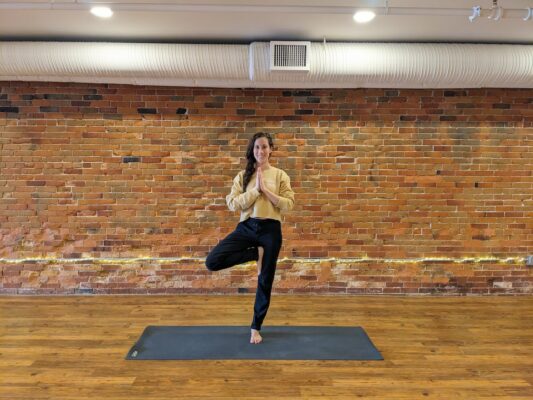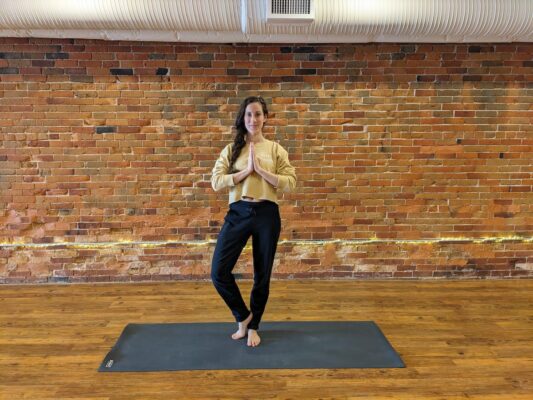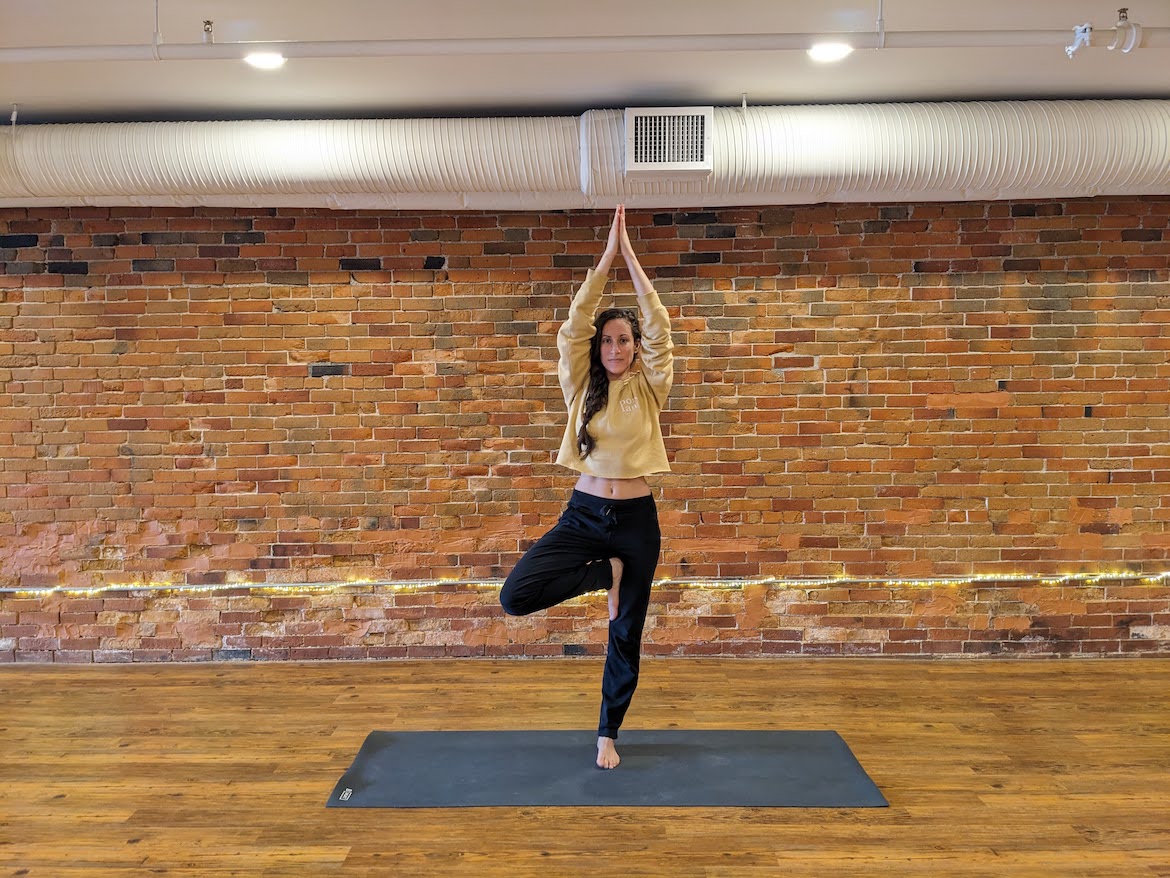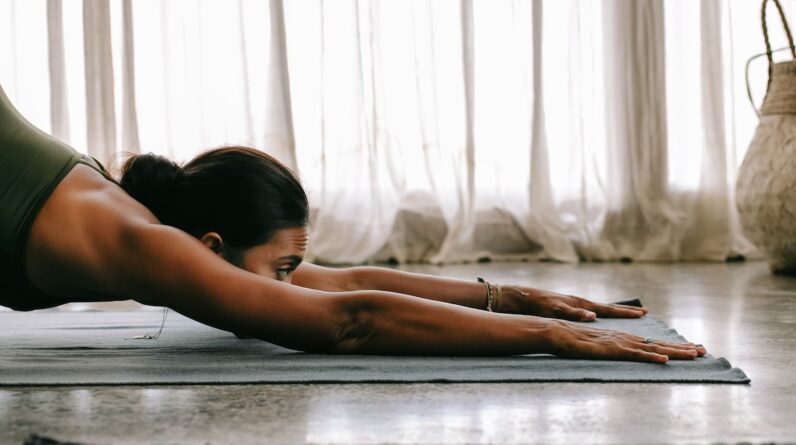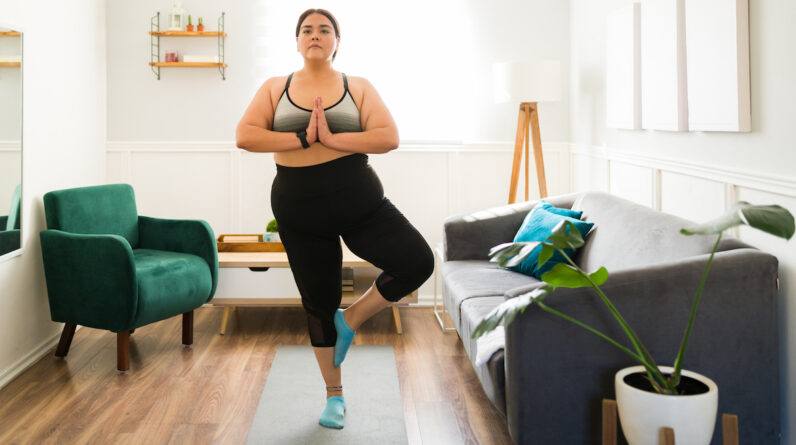
Like a tree, this yoga pose illustrates the importance of cultivating a solid foundation that supports growth in all directions, while also inviting us to play with our balance and focus our attention on the here and now.
Nourishing for both body and mind, tree pose is commonly taught to students both young and old, which speaks to the many benefits of this popular standing yoga posture. No matter your age or experience level, this is a pose worth adding to your yoga routine for a lifetime.
Read on to learn how to do it, what the benefits are, common mistakes to avoid, and other tips for beginners.
How to do tree pose the right way
- Begin standing with your feet hip-width distance apart and your hands on your hips.
- Inhale to elongate your spine, then exhale to shift your weight onto your left foot.
- Then bring your right knee up to your chest.
- Place the sole of your right foot against your upper inner left thigh. (You can place the sole of your right foot just below your knee if that’s more comfortable.)
- Inhale and gently open your chest. As you exhale, press your foot and inner leg together to stay centered and strong.
- Bring your palms together in front of your heart in prayer position. (You can keep your hands on your hips for more stability if needed.)
- Stay here for 3 to 5 rounds of breath, then repeat on the other side.
Tree pose benefits
1. It improves your balance
As a standing balancing pose, one of the big players is, you guessed it, balance. And while balance is most definitely a physical action, it’s also kinesthetic, meaning it brings way more than just our leg muscles into focus, but recruits our sensory awareness as well.
While you’re balancing on one leg, you’re fine-tuning your nervous system’s ability to sense where you are in space and improving your focus.
“By narrowing our base of support or removing a point of contact [with the ground], we increase demand on the receptors in our nervous system that help us maintain equilibrium,” says doctor of physical therapy and yoga teacher Lindsay Mayock, DPT.
2. It builds lower-body strength
Balancing on one foot gives your feet and ankles a great workout. Plus, it offers a dynamic stretch in the outer hip of the lifted leg that releases and tones the external rotators.
“Single-leg standing postures improve strength in key hip and pelvic stabilizers, such as the gluteus medius and minimus, which are helpful for stability in the leg and hip,” Mayock says. “Being strong in these muscles is important for both hip and knee health and function. Tree pose is great for this, particularly if we pay attention to ‘growing’ upward and maintaining a level pelvis.”
Tree pose variations to make it easier or harder
1. Modification: Tree pose with toes on the ground
- Begin standing with your feet hip-width distance apart and your hands on your hips.
- Inhale to elongate your spine, then exhale to shift your weight onto your left foot.
- Place the sole of your right foot against your inner left shin and keep your toes on the mat for more stability.
- Inhale and gently open your chest. As you exhale, press your foot and inner leg together to stay centered and strong.
- Bring your palms together in front of your heart in prayer position. (You can keep your hands on your hips for more stability if needed.)
- Stay here for 3 to 5 rounds of breath, then repeat on the other side.
2. Progression: Tree pose with arms overhead
- Begin standing with your feet hip-width distance apart and your hands on your hips.
- Inhale to elongate your spine, then exhale to shift your weight onto your left foot.
- Then bring your right knee up to your chest.
- Place the sole of your right foot against your upper inner left thigh. (You can place the sole of your right foot just below your knee if that’s more comfortable.)
- Inhale and gently open your chest. As you exhale, press your foot and inner leg together to stay centered and strong.
- Bring your palms together in front of your heart in prayer position.
- Inhale to extend your arms up and overhead.
- Stay here for 3 to 5 rounds of breath, then repeat on the other side.
Common tree pose mistakes
The most common mistake made when practicing tree pose is to not engage the muscles of your standing leg. You can tell you’re doing this if your outer hip appears to be dropping or sagging to the side. Even though it’s an asymmetrical pose, balancing your pelvis is key to making sure you squeeze all the juicy benefits out of this dynamic posture.
“Gravity and weakness can result in a dropping of the non-standing side of the pelvis,” Mayock says. “It’s an activation of the standing gluteus medius and minimus muscles—aka your outer hips—that answers gravity and brings the pelvis back to a level position.”
Although it was previously thought to be a mistake, placing the foot of your lifted leg on the inner knee isn’t dangerous if you don’t have a history of knee pain or injury.
“All my research has led me to the understanding that it’s okay to place your foot on the side of your knee,” says Christina Spencer, a yoga teacher and studio manager of Portland Yoga Collective in Portland, Maine. “It’s not going to dislocate your knee.”
Mayock also backs this up, helping to bust a long-standing myth that this may cause injury.
However, if you do put your foot on the inside of your standing knee and feel pain, move your foot higher or lower or exit the pose entirely.
Safety precautions
If you have problems balancing for any reason and/or feel fearful of falling, make sure you practice on a flat, level surface with a comfortable yoga mat and stay near a wall for support.
Tree pose is not recommended for people who are six months pregnant or more because of the higher risk of falling.
FAQ
1. How long should you hold tree pose?
Tree pose can be held for three to five rounds of breath, which equates to 30 seconds or a little less than one minute.
2. What are the disadvantages of tree pose?
There are no disadvantages of tree pose if you’re able to practice it safely. This is an excellent posture to gradually improve your balance, build strength in your hip, knee, and ankle joints, and enhance your ability to stay centered and focused.


